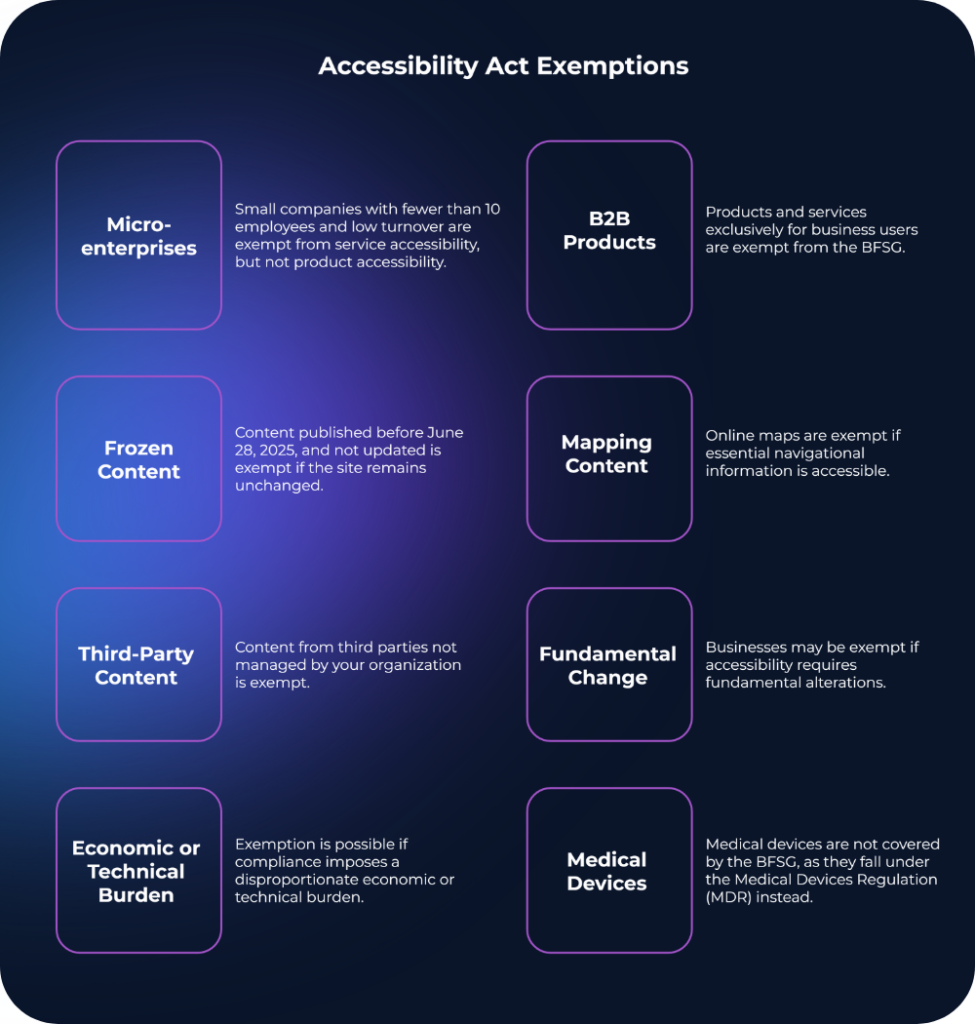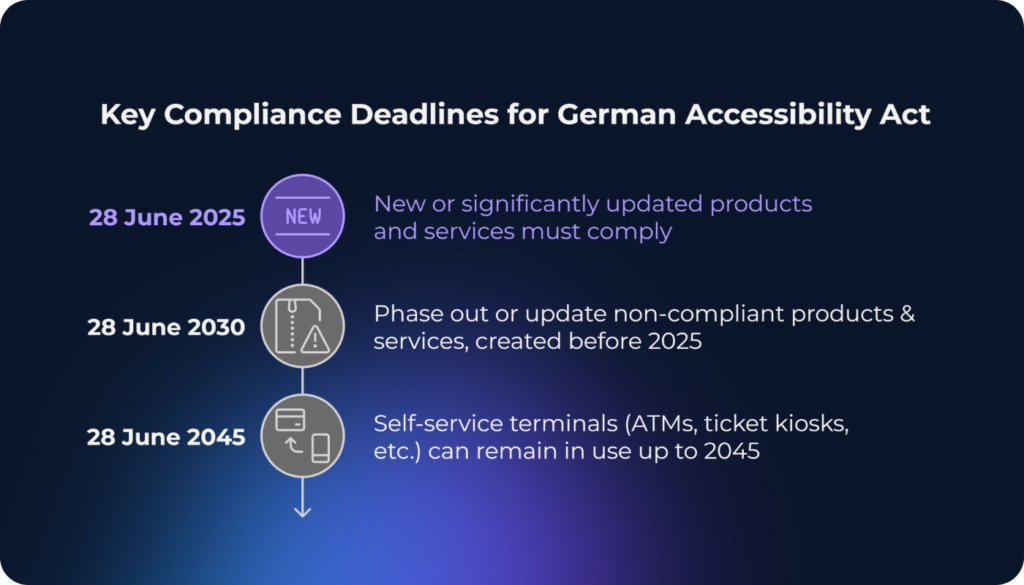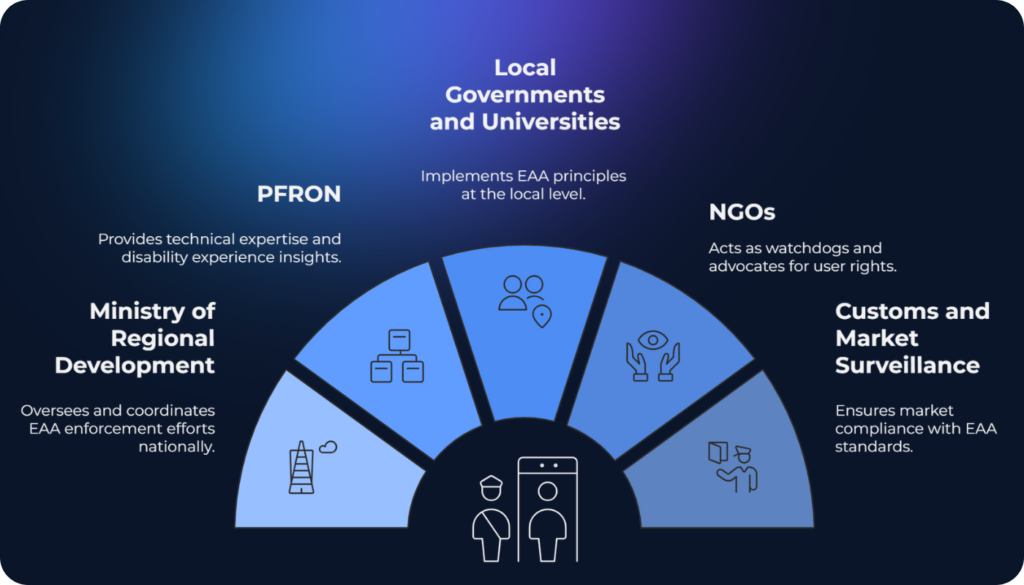EU Accessibility Act in Germany: What Business Can Expect from BFSG?
In our previous article, we explored the main pillars and risks of non-compliance with the European Accessibility Act (Directive 2019/882). Now, let’s turn to Germany — where the Accessibility Act becomes national law under the Barrierefreiheitsstärkungsgesetz (BFSG).
Germany’s national implementation of the EAA came into force on 28 June 2025. The BFSG law is designed to bring key products and services in line with accessibility standards, without expanding beyond the EU baseline like Poland does. While it follows the directive closely, the German Act introduces specific rules around exemptions, enforcement, and transitional periods that businesses should pay attention to.
What Sets the German Act Apart?
Germany has largely aligned its implementation with the requirements of the EU Accessibility Act, introducing specific provisions around enforcement and transitional rules. The national law closely mirrors the directive’s scope and technical standards, relying on WCAG 2.1 Level AA and EN 301 549 as key accessibility benchmarks. The BFSG applies to a defined list of consumer-facing products and services, particularly in the digital, banking, telecom, and retail sectors.
What Products and Services should Be Accessible under German Accessibility Act?
The BFSG applies to a wide range of products and digital services offered to consumers. These include:
Products covered:
- Consumer computer hardware and operating systems
- Self-service terminals:
- Payment terminals, ATMs, ticketing and check-in machines
- Interactive terminals (excluding those integrated into vehicles or transport systems)
- Consumer telecom and media devices with interactive or computing capabilities
- E-book readers
Services covered:
- Consumer telecommunications services (excluding machine-to-machine transmission)
- Elements of passenger transport (air, bus, rail, waterborne), excluding local/regional services
- Websites and mobile apps
- E-tickets and real-time travel information (via interactive screens in the EU)
- Interactive self-service terminals for transport services (within the EU)
- Consumer banking services
- E-books and related software
- E-commerce platforms and services
The law applies to both manufacturers of the listed products and service providers offering them to consumers in the EU market, whether operating within Germany or serving German consumers cross-border. It focuses on areas where digital accessibility has the most direct consumer impact, particularly in everyday commercial transactions and public-facing technologies.
How the European Accessibility Act Affects Businesses in Germany?
Germany’s BFSG transposes the EAA almost directly and not beyond, introducing harmonized technical standards but tailoring its rules for enforcement and timelines. For businesses in banking, insurance, telecom, public sector, e-commerce, and transport, this means:
- All digital content must meet WCAG 2.1 AA accessibility criteria (including accessible PDFs).
- Products and services must function seamlessly with assistive technologies.
- Physical product labels and instructions must meet defined legibility standards.
- Online documentation must be publicly accessible and in an accessible format.
- Businesses must be able to demonstrate compliance efforts through technical documentation, testing reports, and accessibility declarations.
What are Exemptions for German Accessibility Act?
Under Article 4(4) of the European Accessibility Act, the BFSG excludes several areas from its scope:
- Products and services designed solely for professional or business-to-business use — not intended for consumer markets.
- The built environment connected to services, such as physical buildings or facilities, which remains outside the BFSG’s remit.
- Urban, suburban, and regional public transport services — although some elements still fall under accessibility obligations. For example, self-service terminals for ticketing or check-in must comply, while the associated websites and mobile apps are usually regulated under the Public Sector Web Accessibility Directive (2016/2102).

The BFSG also avoids certain broader equality objectives found in other German laws, such as specific protections for women with disabilities or the expanded anti-discrimination grounds listed in § 1 of the General Act on Equal Treatment (AGG).
Exemption for Microenterprises
Microenterprises — defined as having fewer than 10 employees and an annual turnover or balance sheet total under €2 million — are exempt from the BFSG’s mandatory requirements.
This exemption narrows the law’s reach for the smallest businesses, while leaving SMEs and large enterprises fully accountable for compliance.
Controlled Exemptions for Legacy Systems and Contracts
Germany has also introduced targeted transitional provisions to avoid immediate disruption:
- Service contracts signed before 28 June 2025 can continue without modification until they end, but no later than 27 June 2030.
- Self-service terminals (e.g., ATMs, ticket machines, kiosks) installed before 28 June 2025 may remain in operation for up to 15 years from installation, provided they met applicable standards at the time.
- Existing devices and software are not subject to retroactive changes — but any new deployment after June 2025 must meet BFSG requirements immediately.
These measures create phased compliance pressure: companies have more time to address older assets, but cannot delay upgrades indefinitely.
Considerations for Medical and Digital Health Products
Medical devices themselves are generally excluded from the BFSG. However, exceptions apply if:
- The device’s software is accessed via a covered product, such as a smartphone or tablet.
- An online platform sells medical devices or provides related services directly to consumers — such as registration, appointment booking, or e-commerce transactions.
In these cases, the digital interface must meet BFSG accessibility requirements.
Other Notable Exemptions
The BFSG also recognises situations where accessibility obligations do not apply, including:
- Third-party content not funded, developed, or controlled by the economic operator.
- Certain local and regional public transport services, unless other German or EU laws impose accessibility requirements.
- Medical devices, unless accessed through a covered consumer-facing interface, in which case the interface must still comply.
Disclosure Rules for Digital and Physical Accessibility
While the BFSG mandates accessibility, it references “essential requirements” in EU law and harmonized standards rather than prescribing every technical detail.The BFSG applies to a wide range of products and digital services offered to consumers. Two standards are central for proving compliance:
- EN 301 549 – Harmonized European ICT accessibility standard.
- WCAG 2.1 AA – International benchmark for digital accessibility, incorporated into EN 301 549.
These standards define measurable requirements for:
For Physical Products:
- Labels and instructions must have adequate font size, colour contrast, and spacing.
- Information must be available in multiple sensory forms — supporting users with visual, auditory, or cognitive disabilities.
For Digital Documentation (including PDFs):
- Documentation must be available online in accessible PDF format meeting WCAG and EN 301 549.
- The link (URL) to the accessible version must be clearly printed on packaging or product materials.
- Content must be fully compatible with assistive technologies such as:
- Screen readers (JAWS, NVDA)
- Braille displays
- AAC (Alternative and Augmentative Communication) systems
What are Penalties for BFSG Incompliance?
Germany has introduced clear enforcement mechanisms. Non-compliance can result in administrative fines of up to €100,000, as well as potential market restrictions or product bans. Enforcement will be overseen by designated national authorities – such as market surveillance bodies and state-level regulators (Länder) – who may monitor compliance and act on violations under general fair trading rules.
Businesses should also be aware that failure to comply could invite legal challenges or reputational risks, especially in sectors with high public visibility.
What is a Transitional Periods for Accessibility Act in Germany?
The BFSG enters into force on 28 June 2025, with the following transitional arrangements:
- Existing service contracts signed before 28 June 2025 can remain unchanged until they end, but no later than 27 June 2030, including streaming subscriptions and similar services
- Service providers may continue using older products, such as tablets, smartphones or e-book readers, that were lawfully in use before 28 June 2025, until 27 June 2030
- Self-service terminals installed before 28 June 2025 may remain in use for up to 15 years from their installation date, provided they complied with the rules in force at the time

For example, a telecom provider offering self-service kiosks for SIM registration installed in 2022 can continue using them until 2030, while a new installation after 2025 must meet accessibility requirements from day one. Similarly, online service contracts signed before June 2025 need not be retroactively updated for compliance.
These transitional measures are intended to give businesses time to phase in upgrades without disrupting service continuity.
How Quertum supports your Accessibility Journey and Compliance with EAA?
Navigating accessibility requirements under the European Accessibility Act (EAA) doesn’t have to be overwhelming. Quertum helps you make sense of technical standards like WCAG, PDF/UA, and EN 301 549 — and puts them into action, across your real-world documents and systems.
Whether you’re in banking, insurance, telecom, or the public sector, we help ensure your communication channels are compliant, user-friendly, and ready for the new legal landscape in Germany and across the EU.
With Quertum, you get:
✅ Document audits you can act on
We don’t just flag issues — we tell you what they mean and how to fix them. From PDF templates to legacy systems, we identify the gaps and help you close them fast.
✅ Accessibility retrofitting that fits your stack
We integrate with your existing Document Management Systems & Customer Communication Management systems and your workflows — no need to rebuild from scratch.
✅ Compliance that scales with your DMS & CCM
Accessibility is not a one-time project. We help you set up repeatable, scalable processes to ensure ongoing compliance — across teams, channels, and output.
From legal interpretations to tech implementation, our cross-functional team supports you in translating regulations into practical solutions — without the jargon. Start your accessibility journey with confidence.
Summary
Germany’s implementation of the European Accessibility Act offers clarity and consistency, staying faithful to the original directive while acknowledging industry realities through exemptions and phase-ins. For businesses operating in Germany or serving German consumers, the upcoming enforcement date presents both a legal obligation and an opportunity to embed accessibility into product design, customer experiences, and digital infrastructure.
Taking action now means not just avoiding penalties, but building more inclusive services that meet evolving customer expectations.
Next steps for businesses:
- Audit your current digital products and services
- Identify contracts, platforms, and hardware in use before June 2025
- Begin planning for technical upgrades, staff training, and documentation
- Monitor upcoming guidance from German authorities



